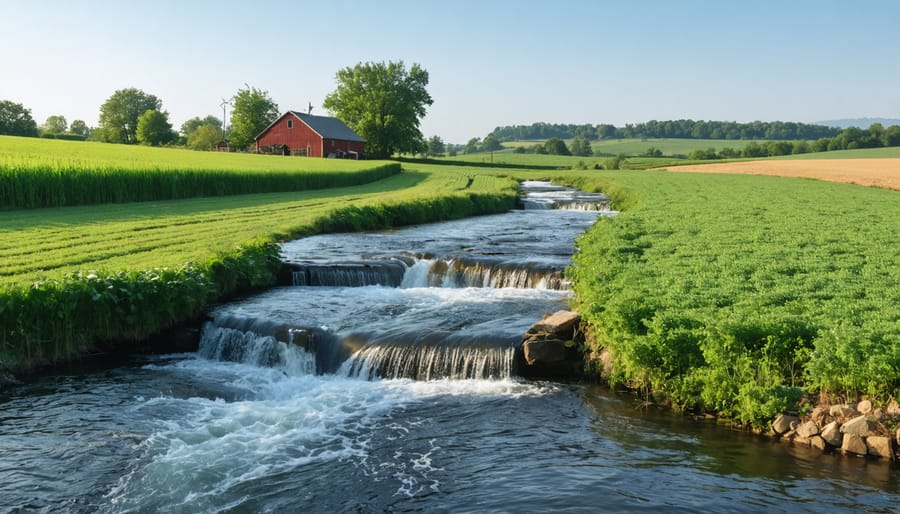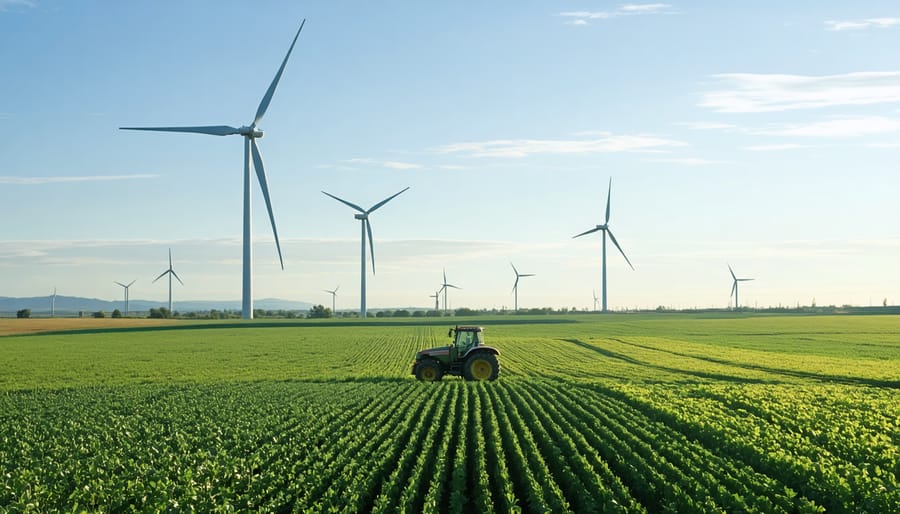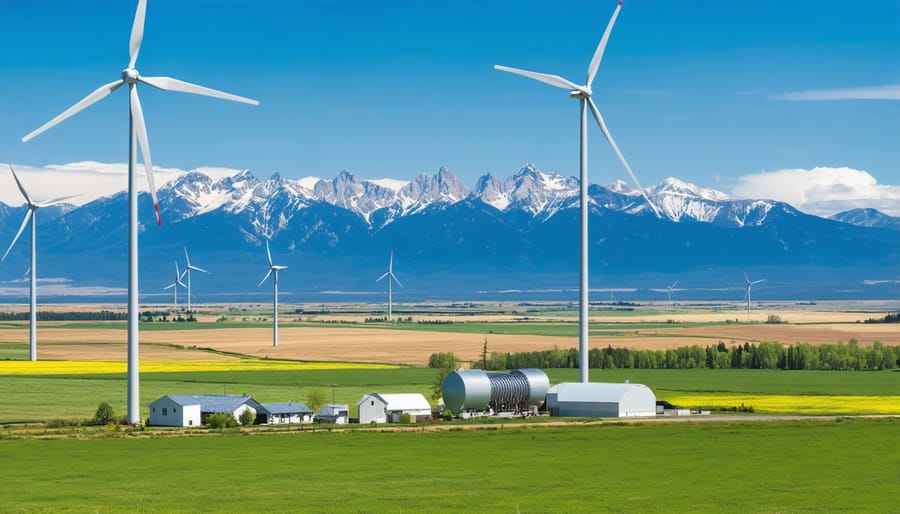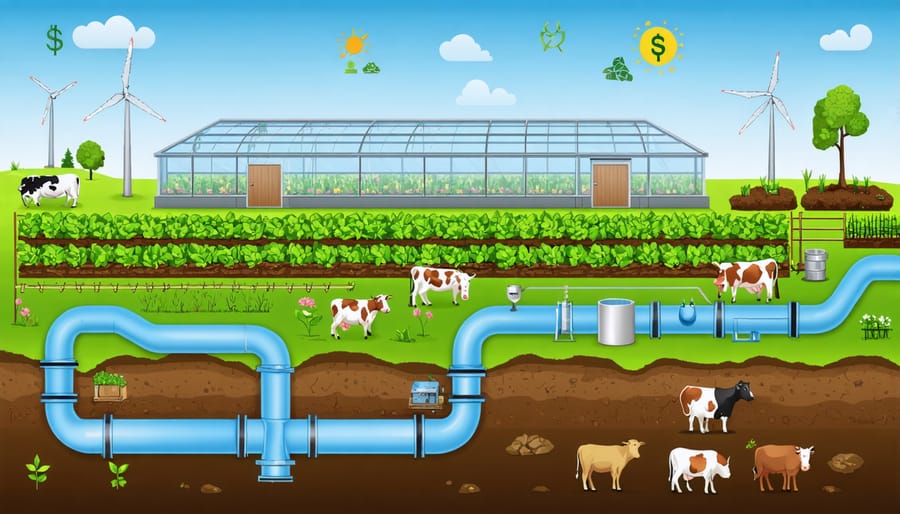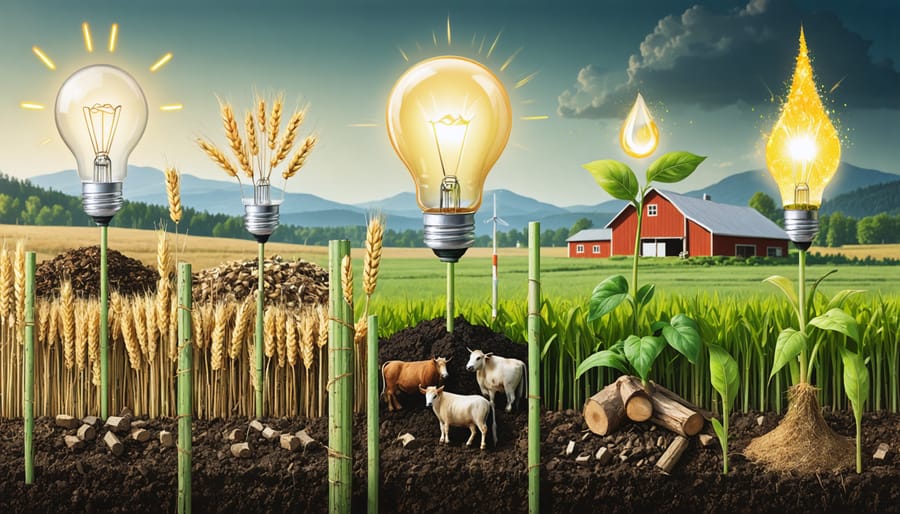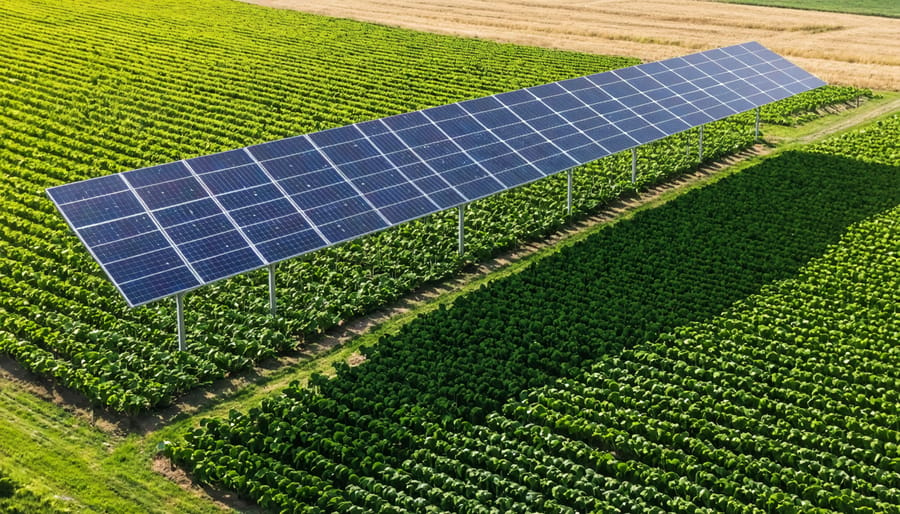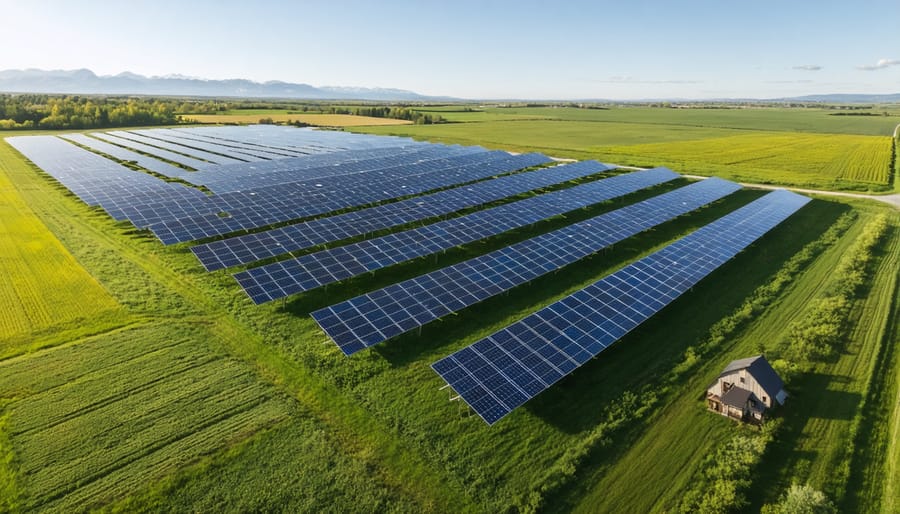Harness the untapped potential of your property’s water resources with micro hydropower systems – a proven technology generating reliable, clean electricity from streams and irrigation channels. Unlike other renewable energy microgrids, micro hydro provides consistent power output 24/7, making it an ideal solution for Canadian farmers seeking energy independence.
Operating at scales between 5-100 kilowatts, these systems can power entire farm operations while reducing annual electricity costs by 50-70%. For Alberta farmers with suitable water resources, micro hydro installations typically pay for themselves within 5-7 years through reduced utility bills and potential power export credits.
Recent innovations in turbine design and control systems have made micro hydro more accessible than ever, with modular components that integrate seamlessly with existing irrigation infrastructure. These systems now require minimal maintenance while delivering decades of reliable service – a compelling advantage for agricultural operations focused on long-term sustainability and economic efficiency.
How Micro Hydropower Works on Your Farm
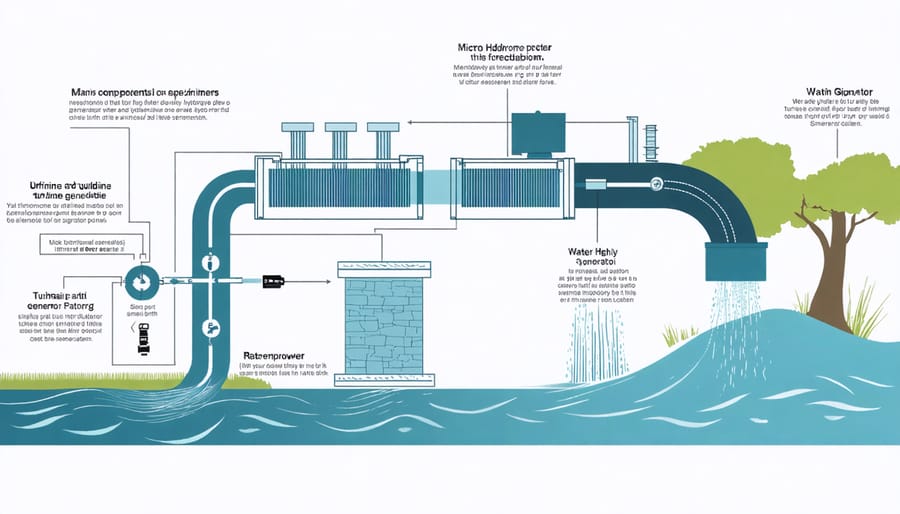
Essential Components
A well-designed micro hydropower system relies on three key components working together seamlessly. The heart of the system is the turbine, which converts flowing water into mechanical energy. For most Alberta farms, Pelton wheels work best for high-head situations, while cross-flow turbines are ideal for streams with higher water volume but lower head.
The generator transforms this mechanical energy into electricity, with permanent magnet generators being the most common choice for farm installations due to their reliability and minimal maintenance requirements. These typically connect to farm energy storage solutions to ensure consistent power availability.
The control system manages power output and protects the equipment. Modern controllers include load management features, helping you balance power usage across your farm operations. They also provide essential monitoring capabilities, allowing you to track system performance through user-friendly digital displays.
For optimal performance in our prairie climate, these components need proper weatherproofing and insulation. Many Alberta farmers house their equipment in small, insulated sheds near the water source, ensuring year-round operation even during harsh winters.
Water Requirements and Flow Calculations
To determine your property’s hydropower potential, you’ll need to assess two key factors: head (vertical drop) and flow rate. The head can be measured using a surveyor’s level or GPS device, while flow rate is typically calculated in litres per second.
For flow measurement, start by tracking your water source’s seasonal variations. In Alberta, spring runoff usually provides peak flow, while late summer might see reduced levels. A simple method is the float test: measure the time it takes for a floating object to travel a set distance in your stream. Multiply the surface speed by 0.8 to account for friction.
To calculate potential power output in watts, use this formula:
Power = Head (metres) × Flow (L/s) × 9.81 × System Efficiency (typically 0.5)
For example, a site with a 10-metre head and 20 L/s flow could generate:
10 × 20 × 9.81 × 0.5 = 981 watts
Remember that Alberta’s water licensing requirements must be met before installation. It’s recommended to collect flow data over at least 12 months to account for seasonal variations and ensure your system will meet your farm’s power needs year-round.
Integrating with Farm Irrigation Systems
Dual-Purpose Design
For Alberta farmers looking to maximize their water resources, dual-purpose micro hydropower systems offer an innovative approach to farm energy efficiency and irrigation management. These systems cleverly utilize the same water flow for both power generation and crop irrigation, creating a sustainable cycle that benefits both energy production and agricultural needs.
The key to successful implementation lies in strategic system placement. By positioning the hydropower turbine upstream from irrigation zones, farmers can harness energy from water flow before it reaches the crops. This setup typically involves a drop structure or pressure-reducing valve that would otherwise dissipate energy, instead converting it into usable electricity.
Many Alberta farmers have found success with this approach. For example, the Thompson family farm near Red Deer uses their irrigation canal’s natural elevation drop to generate 5 kW of power while maintaining consistent water flow for their 200-hectare operation. Their system includes a bypass channel that ensures irrigation isn’t compromised during maintenance or peak growing seasons.
The dual-purpose design also helps reduce operational costs. By integrating power generation with existing irrigation infrastructure, farmers can minimize initial installation expenses while achieving two essential functions. During non-irrigation seasons, the full water flow can be directed through the turbine, maximizing power generation when crop watering isn’t required.
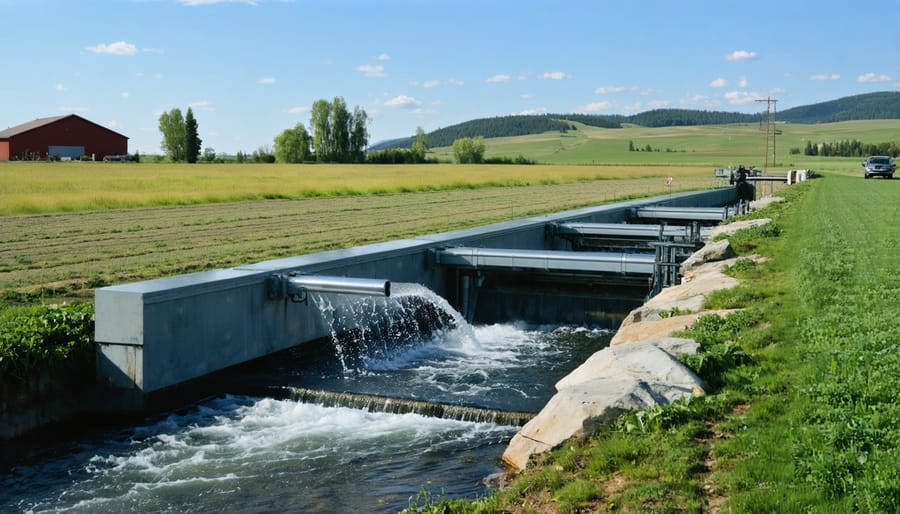
Seasonal Considerations
Alberta’s distinct seasonal changes significantly impact micro hydropower system performance throughout the year. During spring runoff, typically from March to June, systems often experience peak production as melting snow increases water flow. This natural boost provides an excellent opportunity to store excess energy for later use or redirect it to high-demand agricultural operations like irrigation systems.
Winter presents unique challenges, with freezing temperatures potentially affecting water flow and equipment. Installing heated covers and insulated piping helps prevent ice formation, while maintaining consistent water flow through motion helps resist freezing. Some Alberta farmers report success with deep-water intake systems that draw from below the frost line, ensuring year-round operation.
Summer months might see reduced water levels in some streams, particularly during July and August. Having a storage pond or reservoir can help maintain consistent power generation during these drier periods. Many successful installations in southern Alberta incorporate water storage solutions that collect spring runoff for use during lower-flow periods.
Fall maintenance is crucial for system longevity. This is the ideal time to clear debris, check for wear on turbine components, and prepare the system for winter. Local farmers often schedule their major maintenance during October when agricultural demands typically decrease.
Regular monitoring of seasonal water patterns helps optimize system performance. Many Alberta operators maintain detailed records of flow rates across seasons, allowing them to better predict and plan for seasonal variations in power generation.
Real Success Stories from Alberta Farms
The Henderson family farm near Red Deer stands as a shining example of micro hydropower success in Alberta. In 2019, they installed a 5 kW system on their existing irrigation canal, which now powers their dairy operation’s milk cooling system and barn lighting. “We’re saving roughly $400 monthly on electricity costs,” shares John Henderson. “The system paid for itself faster than we expected, especially with the provincial renewable energy grants we accessed.”
In Pincher Creek, the Martens’ mixed farming operation harnesses power from a small creek running through their property. Their 3 kW system, installed in 2020, provides reliable power for their greenhouse operations and workshop. Sarah Martens notes, “What surprised us most was how consistent the power generation remained, even during drier months, thanks to our properly designed water storage system.”
The Mountain View Hutterite Colony near Cardston demonstrates how micro hydropower can support larger agricultural operations. Their 12 kW system, drawing from an irrigation reservoir, powers their poultry barns and grain processing facility. Colony manager David Wurz reports a 30% reduction in annual energy costs since installation in 2018.
Near Rocky Mountain House, the Zhang family’s market garden operation showcases a smaller-scale success story. Their 2 kW system, utilizing a natural spring on their property, powers their cold storage facility and irrigation pumps. “We invested $15,000 initially,” explains Lisa Zhang, “and received excellent support from local renewable energy consultants throughout the planning and installation process.”
These success stories share common elements: thorough planning, professional assessments of water resources, and strategic use of available grants and incentives. Each farm adapted their system to their specific needs and water resources, proving that micro hydropower can be a viable option for various agricultural operations across Alberta.
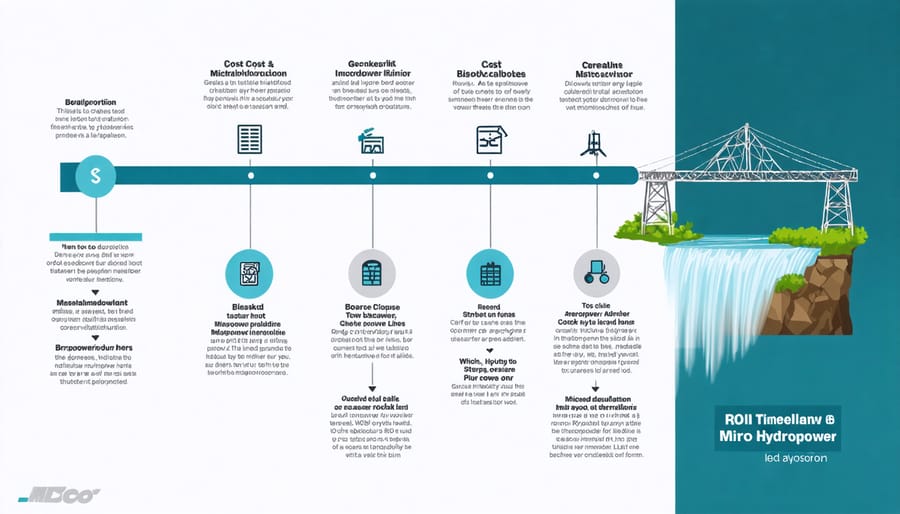
Cost and Return on Investment
Available Grants and Incentives
Several funding opportunities are available to help Alberta farmers implement micro hydropower systems. The Federal Government’s Agricultural Clean Technology Program offers up to 50% cost-sharing for clean energy projects, including micro hydro installations, with maximum funding of $2 million for for-profit organizations.
The Alberta Agriculture and Irrigation’s On-Farm Energy Management Program provides grants covering 50% of eligible costs up to $50,000 for energy-efficient upgrades, including micro hydropower installations. Farmers can combine this with the Canadian Agricultural Partnership (CAP) funding, which offers additional support for sustainable farming practices.
Rural municipalities often provide supplementary grants through their Agricultural Service Boards. The Municipal Climate Change Action Centre (MCCAC) also offers periodic funding opportunities for renewable energy projects in rural Alberta.
Remember to consult with local watershed organizations, as they sometimes provide matching funds for projects that demonstrate sustainable water management. The Alberta Water Portal Society maintains an updated database of available water-related grants and can assist with application processes.
Installation and Maintenance Guidelines
Installing a micro hydropower system starts with a thorough site assessment by a qualified professional. For Alberta farmers, this typically involves mapping your water source’s flow rate and head height during different seasons. Remember that installation is best done during low-flow periods, usually late summer or early fall.
Begin by securing necessary permits from your local municipality and Alberta Environment and Parks. The intake structure should be positioned upstream, equipped with debris screens to prevent clogging. When laying the penstock (pipeline), ensure proper trenching at least 1 metre deep to prevent freezing during harsh prairie winters.
Regular maintenance is crucial for system longevity. Develop a monthly checklist that includes:
– Clearing debris from intake screens
– Inspecting the penstock for leaks
– Checking turbine bearings and lubrication
– Monitoring electrical connections
– Testing backup systems
During spring runoff, increase inspection frequency to weekly. For winter operation, install heating elements around crucial components and maintain access paths for emergency maintenance. Many Alberta farmers schedule major maintenance during harvest downtime.
Keep detailed maintenance logs and establish relationships with local hydropower technicians for emergency repairs. Consider joining regional farmer networks to share maintenance tips and resources. Most systems require professional servicing annually, typically costing between $500-1,000, depending on system size and complexity.
Micro hydropower systems offer a sustainable and reliable energy solution for Canadian farmers, providing both environmental and economic benefits. By harnessing the natural flow of water on your property, you can generate clean electricity while reducing your carbon footprint and energy costs. As we’ve seen from successful implementations across Alberta, these systems can pay for themselves within several years while providing decades of reliable power generation. The time is right to explore micro hydropower for your farm, with various government incentives and support programs available to help you get started. Connect with local agricultural extension offices or renewable energy consultants to assess your property’s potential and take the first step toward energy independence. Your investment in micro hydropower today contributes to a more sustainable agricultural future for all Canadian farmers.

